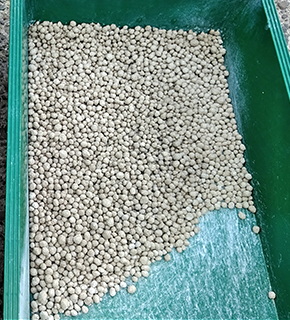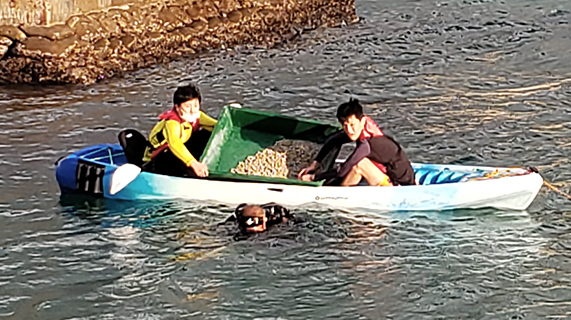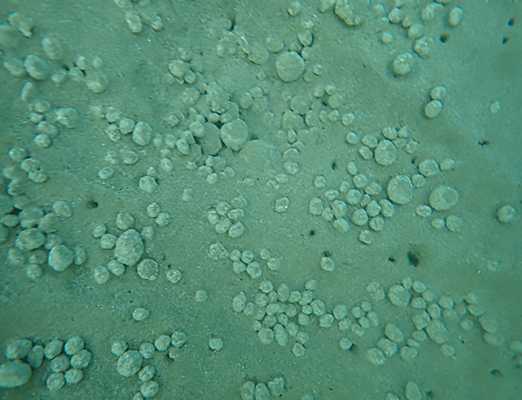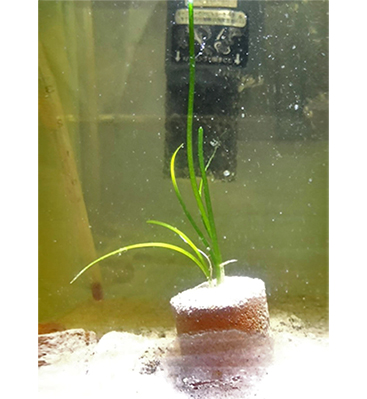Mitsui Chemicals Supports Restoration of Eelgrass Beds with Urea and Microbial Culture Technology
2020.02.27
Mitsui Chemicals, Inc.
Mitsui Chemicals, Inc. (Tokyo: 4183; President & CEO: TANNOWA Tsutomu) today announced its recent product and technological support of a field test undertaken by Associate Professor KUSUBE Masataka of the National Institute of Technology, Wakayama College, with the aim of restoring eelgrass (Zostera marina) beds on the coast of Katakui, Wakayama Prefecture. Eelgrass beds serve both as spawning grounds for aquatic creatures and as a place where larval and juvenile fish can mature. In addition to providing urea, which is used as a raw material in producing biocement, Mitsui Chemicals made available its microbial culture technology for facilitating the mass culture of the microorganisms employed to solidify the biocement.
The biocement developed by Associate Professor Kusube and his team uses sand that is solidified by the microorganisms as they metabolize urea, with this then gradually breaking down in seawater. In effect, eelgrass seeds are embedded in a biocement consisting of sand and sea floor microorganisms from the target area, with the biocement then placed at the bottom of the sea. The biocement then breaks down as the eelgrass grows, returning the environment to its original state to make for a simple, low-impact means of conserving the marine environment without bringing in foreign organisms.
Located at Mitsui Chemicals’ Mobara Research & Development Center in Chiba Prefecture, the bioengineering laboratory used for the mass culture of the microorganisms is a pilot-scale culture facility usually used for determining whether to scale-up the development of bioengineering-related products.
Microorganisms being cultured in the bioengineering laboratory

Eelgrass is a marine plant that mineralizes organic matter in the sea and supplies oxygen to the underwater environment. Eelgrass beds serve both as spawning grounds for aquatic creatures and as a place where larval and juvenile fish can mature. However, environmental pollution and land reclamation resulting from economic growth have caused eelgrass beds to shrink worldwide over the last 30 years,1) with Japan seeing a decrease of approximately 30 percent between 1960 and the 1990s.2) The decline has been particularly pronounced in the Seto Inland Sea, where eelgrass beds have diminished by 70 percent.3)
A number of methods have been used to date in the effort to restore eelgrass beds, including the planting of seedlings in biodegradable plastic containers and the laying of eelgrass seed-woven hemp sheets along the bottom of the sea. However, all such methods have had the potential to add to the problem of ocean waste, necessitating the development of additional technology.
Provided that all has gone smoothly with the field test launched in December 2019 by Associate Professor Kusube and his students at the National Institute of Technology, Wakayama College, there will have been plants germinating in February. The team plans to periodically observe the test site and take seawater samples over the next few years to evaluate the spread of the eelgrass bed and assess the recovery and preservation of aquatic creatures. The microorganisms mass-cultured at Mitsui Chemicals’ bioengineering laboratory will be stored at the college in Wakayama with a view to using them in future field tests.
Mitsui Chemicals intends to continue making wide-ranging contributions to solving a variety of social issues through its business activities.
Biocement

Scattering it onto the sea floor

Eelgrass

Biocement in the sea

Anticipated germination
(plant grown in a preliminary experiment)

*Reference materials and sources
1) KIKUCHI Taiji (1974) ‘Recent advances in the studies on seagrass ecosystem,’ Benthos research, pp. 1–21.
2) Biodiversity Center of Japan, ‘Tidal Flats, Seaweed Beds and Coral Reefs Survey,’ Natural Environment Survey.
3) Ministry of the Environment, ‘Report on a Fact-finding Survey of Tidal Flats in the Seto Inland Sea.’
